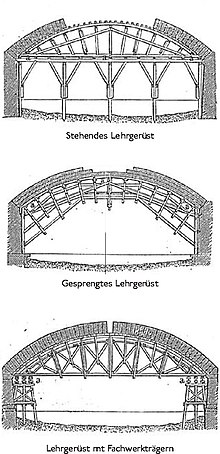Falsework
A falsework is an auxiliary construction in the building industry in the early walls of arches and vaults was used today and in particular in concrete bridge construction as a shuttering scaffold for shaping and attachment of the concrete form is used.
The wooden falsework serves as the basis for bricked vaults or arches. The individual building blocks are built directly onto the falsework. Once the vault or arch has achieved the necessary strength, the falsework can be carefully lowered and removed. The shape of the vault now supports itself.
Falsework has been used in construction since ancient times and is still used today in building walls. Depending on the shape of the vaults, the falsework is semicircular, segmented, ogive and, depending on the load to be carried, stronger or weaker. In the case of simple vaults , for example to support barrel vaults or hollow vaults, they usually consist of individual plank arches that are connected by battens. With more complex vaults such as groin vaults , they also contain diagonal arches .
In arch bridge construction in particular, there was no alternative to using falsework until the beginning of the 20th century. One differentiates here
- standing falsework
- where the scaffolding is mounted on vertical posts over the entire length of the space to be bridged.
- blown up falsework
- in which the scaffolding structure leaves the space to be bridged free and rests on two points near the arched foundations.
- Falsework with trusses
- which consist of two parts, the upper falsework with training arches and supports on which the scaffolding rests.
A falsework consists of a teaching arch and a stiffening and supporting substructure. The wooden wreaths on which the actual masonry arch is built are mounted on the arch. The position of a falsework can be corrected using wedges or eccentric disks. After the masonry work had been completed, the falsework was often knocked out; in the case of reusable scaffolding, emptying sandboxes or sandbags were also used to lower the scaffolding.
With the introduction of reinforced concrete or prestressed concrete girder bridges , the scaffolding structures have been greatly simplified and today essentially consist of steel lattice structures, the so-called scaffolding trusses.
gallery
The picture Construction of the Devil's Bridge shows a falsework of the second Devil's Bridge , Schöllenenschlucht, Switzerland
Falsework of the Roman bridge in Grins (Tyrol) from 1639 that was not removed
Falsework of the Pont de Montanges , France
Wooden falsework for the Lorraine Viaduct with a span of 146 m, 1938
See also
Web links
- Andreas Kessler: A temporary work of art
- Illustrated descriptions of falsework at Zeno.org
- Lehrgerüst , Viktor von Röll (Ed.): Enzyklopädie des Eisenbahnwesens , 2nd edition 1912–1923, Vol. 7, pp. 74–81
- Lehrgerüst , Lueger: Lexicon of the entire technology , vol. 6, pp. 118-120
- Lehrgerüst , Meyers Großes Konversations-Lexikon , Vol. 12, p. 346






